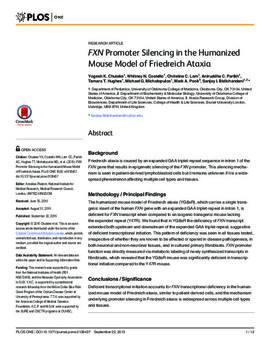| dc.contributor.author | Yogesh K. Chutake | |
| dc.contributor.author | Whitney N. Costello | |
| dc.contributor.author | Christina C. Lam | |
| dc.contributor.author | Aniruddha C. Parikh | |
| dc.contributor.author | Tamara T. Hughes | |
| dc.contributor.author | Michael G. Michalopulos | |
| dc.contributor.author | Mark A. Pook | |
| dc.contributor.author | Sanjay I. Bidichandani | |
| dc.date.accessioned | 2017-03-05T22:55:11Z | |
| dc.date.available | 2017-03-05T22:55:11Z | |
| dc.date.issued | 2015-09-22 | |
| dc.identifier.citation | Chutake YK, Costello WN, Lam CC, Parikh AC, Hughes TT, Michalopulos MG, et al. (2015) FXN Promoter Silencing in the Humanized Mouse Model of Friedreich Ataxia. PLoS ONE 10(9): e0138437. doi:10.1371/journal.pone.0138437 | en_US |
| dc.identifier.uri | https://hdl.handle.net/11244/49272 | |
| dc.description | This research was supported by grants from the National Institutes of Health (R01 NS072418), and the Muscular Dystrophy Association to S.I.B. Y.K.C. is supported by a postdoctoral research fellowship from the Million Dollar Bike Ride Grant Program of the Orphan Disease Center at University of Pennsylvania. T.T.H. was supported by the American College of Medical Genetics Foundation. A.C.P. and M.G.M. were supported by the SURE and OSCTR programs at OUHSC, respectively. | en_US |
| dc.description | | en_US |
| dc.description.abstract | Background Friedreich ataxia is caused by an expanded GAA triplet-repeat sequence in intron 1 of the FXN gene that results in epigenetic silencing of the FXN promoter. This silencing mechanism is seen in patient-derived lymphoblastoid cells but it remains unknown if it is a widespread phenomenon affecting multiple cell types and tissues. Methodology / Principal Findings The humanized mouse model of Friedreich ataxia (YG8sR), which carries a single transgenic insert of the human FXN gene with an expanded GAA triplet-repeat in intron 1, is deficient for FXN transcript when compared to an isogenic transgenic mouse lacking the expanded repeat (Y47R). We found that in YG8sR the deficiency of FXN transcript extended both upstream and downstream of the expanded GAA triplet-repeat, suggestive of deficient transcriptional initiation. This pattern of deficiency was seen in all tissues tested, irrespective of whether they are known to be affected or spared in disease pathogenesis, in both neuronal and non-neuronal tissues, and in cultured primary fibroblasts. FXN promoter function was directly measured via metabolic labeling of newly synthesized transcripts in fibroblasts, which revealed that the YG8sR mouse was significantly deficient in transcriptional initiation compared to the Y47R mouse. Conclusions / Significance Deficient transcriptional initiation accounts for FXN transcriptional deficiency in the humanized mouse model of Friedreich ataxia, similar to patient-derived cells, and the mechanism underlying promoter silencing in Friedreich ataxia is widespread across multiple cell types and tissues. | en_US |
| dc.language.iso | en_US | en_US |
| dc.publisher | PLos One | |
| dc.relation.ispartofseries | PLoS ONE 10(9): e0138437 | |
| dc.relation.uri | http://www.plosone.org/article/info%3Adoi%2F10.1371%2Fjournal.pone.0138437 | |
| dc.rights | Attribution 3.0 United States | |
| dc.rights.uri | https://creativecommons.org/licenses/by/3.0/us/ | |
| dc.subject | DNA methylation,Mouse models,Fibroblasts,Melting,DNA transcription,Cultured fibroblasts,Introns,Polymerase chain reaction | en_US |
| dc.title | FXN Promoter Silencing in the Humanized Mouse Model of Friedreich Ataxia | en_US |
| dc.type | Research Article | en_US |
| dc.description.peerreview | Yes | en_US |
| dc.description.peerreviewnotes | http://www.plosone.org/static/editorial#peer | en_US |
| dc.identifier.doi | 10.1371/journal.pone.0138437 | en_US |
| dc.rights.requestable | false | en_US |

